2005 BUICK CENTURY ECU
[x] Cancel search: ECUPage 221 of 348
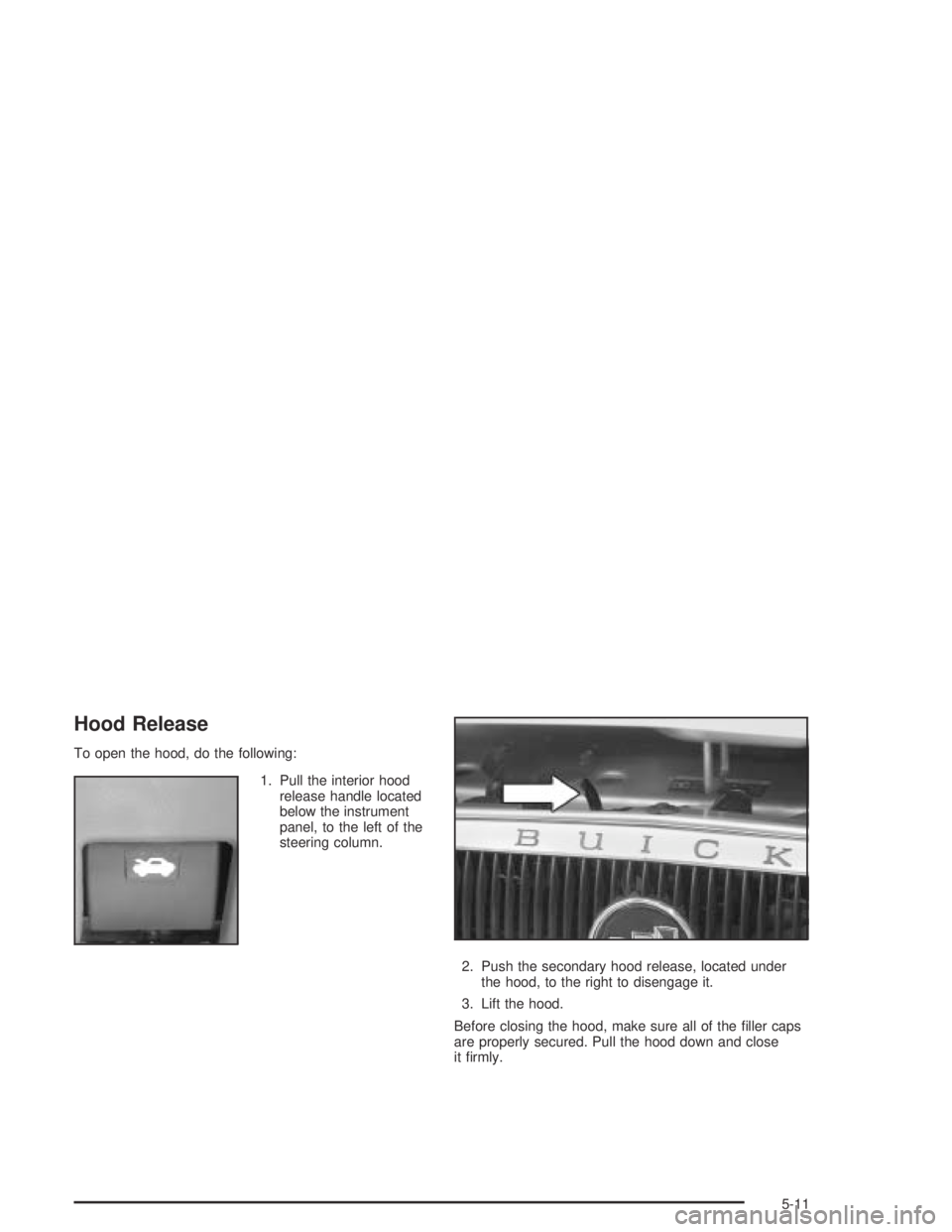
Hood Release
To open the hood, do the following:
1. Pull the interior hood
release handle located
below the instrument
panel, to the left of the
steering column.
2. Push the secondary hood release, located under
the hood, to the right to disengage it.
3. Lift the hood.
Before closing the hood, make sure all of the �ller caps
are properly secured. Pull the hood down and close
it �rmly.
5-11
Page 262 of 348
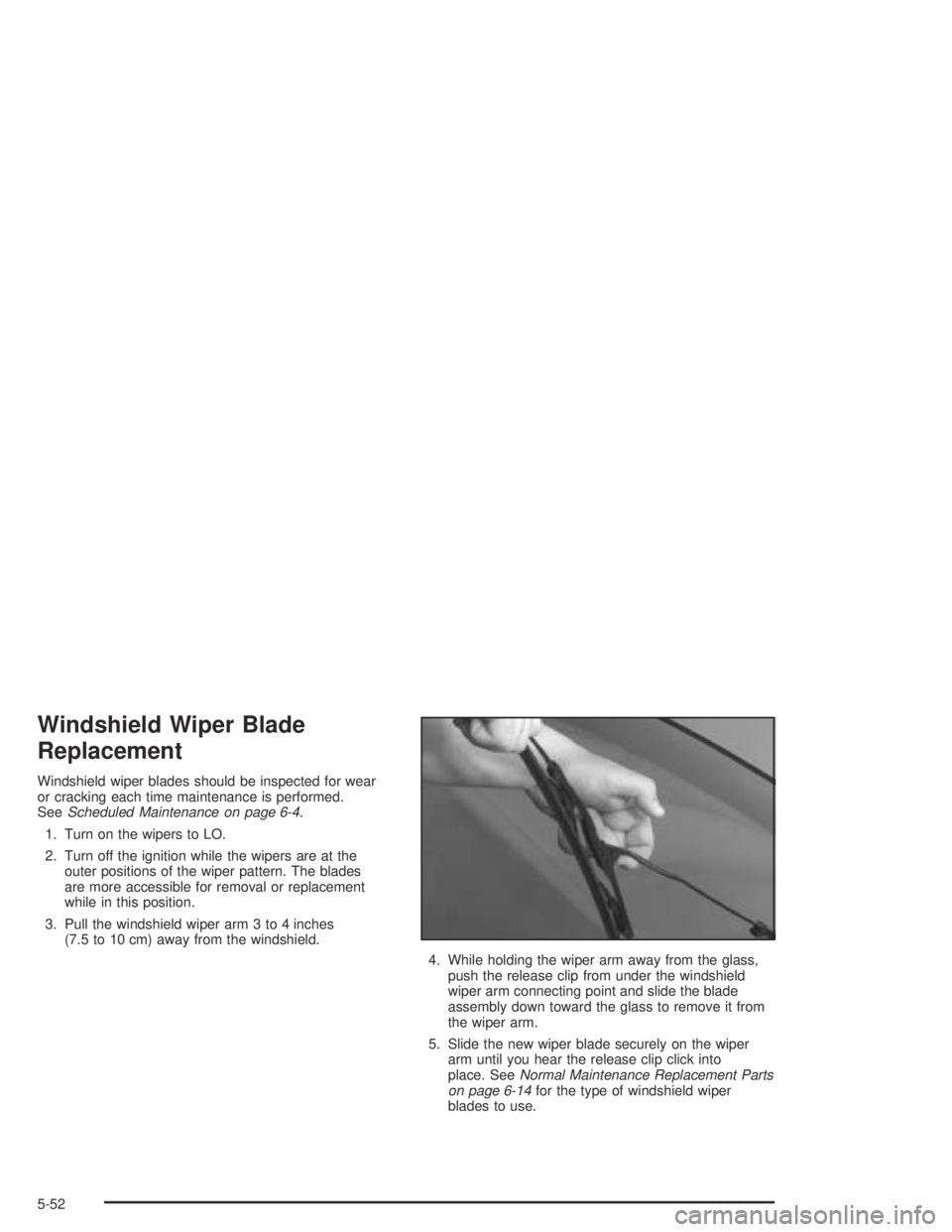
Windshield Wiper Blade
Replacement
Windshield wiper blades should be inspected for wear
or cracking each time maintenance is performed.
SeeScheduled Maintenance on page 6-4.
1. Turn on the wipers to LO.
2. Turn off the ignition while the wipers are at the
outer positions of the wiper pattern. The blades
are more accessible for removal or replacement
while in this position.
3. Pull the windshield wiper arm 3 to 4 inches
(7.5 to 10 cm) away from the windshield.
4. While holding the wiper arm away from the glass,
push the release clip from under the windshield
wiper arm connecting point and slide the blade
assembly down toward the glass to remove it from
the wiper arm.
5. Slide the new wiper blade securely on the wiper
arm until you hear the release clip click into
place. SeeNormal Maintenance Replacement Parts
on page 6-14for the type of windshield wiper
blades to use.
5-52
Page 278 of 348
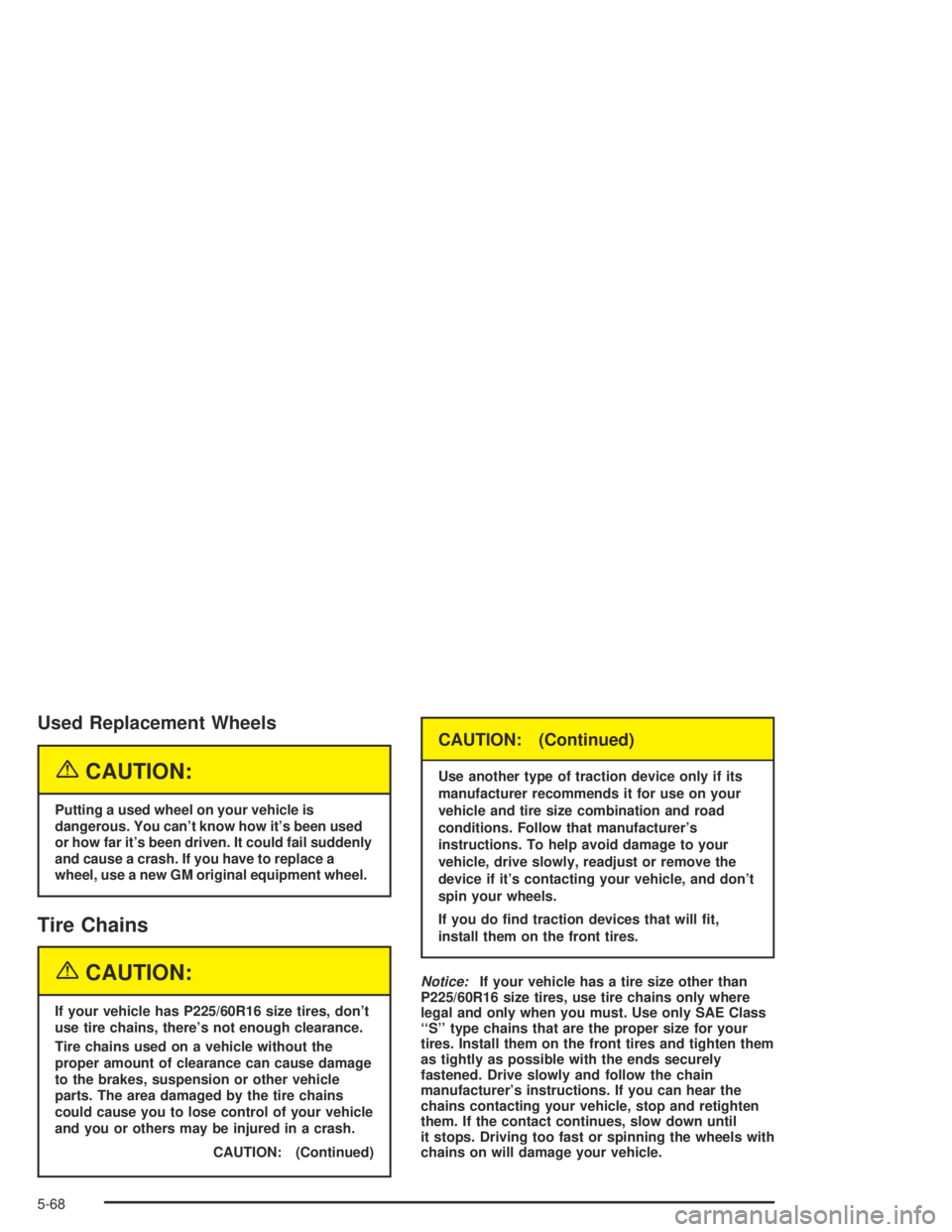
Used Replacement Wheels
{CAUTION:
Putting a used wheel on your vehicle is
dangerous. You can’t know how it’s been used
or how far it’s been driven. It could fail suddenly
and cause a crash. If you have to replace a
wheel, use a new GM original equipment wheel.
Tire Chains
{CAUTION:
If your vehicle has P225/60R16 size tires, don’t
use tire chains, there’s not enough clearance.
Tire chains used on a vehicle without the
proper amount of clearance can cause damage
to the brakes, suspension or other vehicle
parts. The area damaged by the tire chains
could cause you to lose control of your vehicle
and you or others may be injured in a crash.
CAUTION: (Continued)
CAUTION: (Continued)
Use another type of traction device only if its
manufacturer recommends it for use on your
vehicle and tire size combination and road
conditions. Follow that manufacturer’s
instructions. To help avoid damage to your
vehicle, drive slowly, readjust or remove the
device if it’s contacting your vehicle, and don’t
spin your wheels.
If you do �nd traction devices that will �t,
install them on the front tires.
Notice:If your vehicle has a tire size other than
P225/60R16 size tires, use tire chains only where
legal and only when you must. Use only SAE Class
‘‘S’’ type chains that are the proper size for your
tires. Install them on the front tires and tighten them
as tightly as possible with the ends securely
fastened. Drive slowly and follow the chain
manufacturer’s instructions. If you can hear the
chains contacting your vehicle, stop and retighten
them. If the contact continues, slow down until
it stops. Driving too fast or spinning the wheels with
chains on will damage your vehicle.
5-68
Page 289 of 348
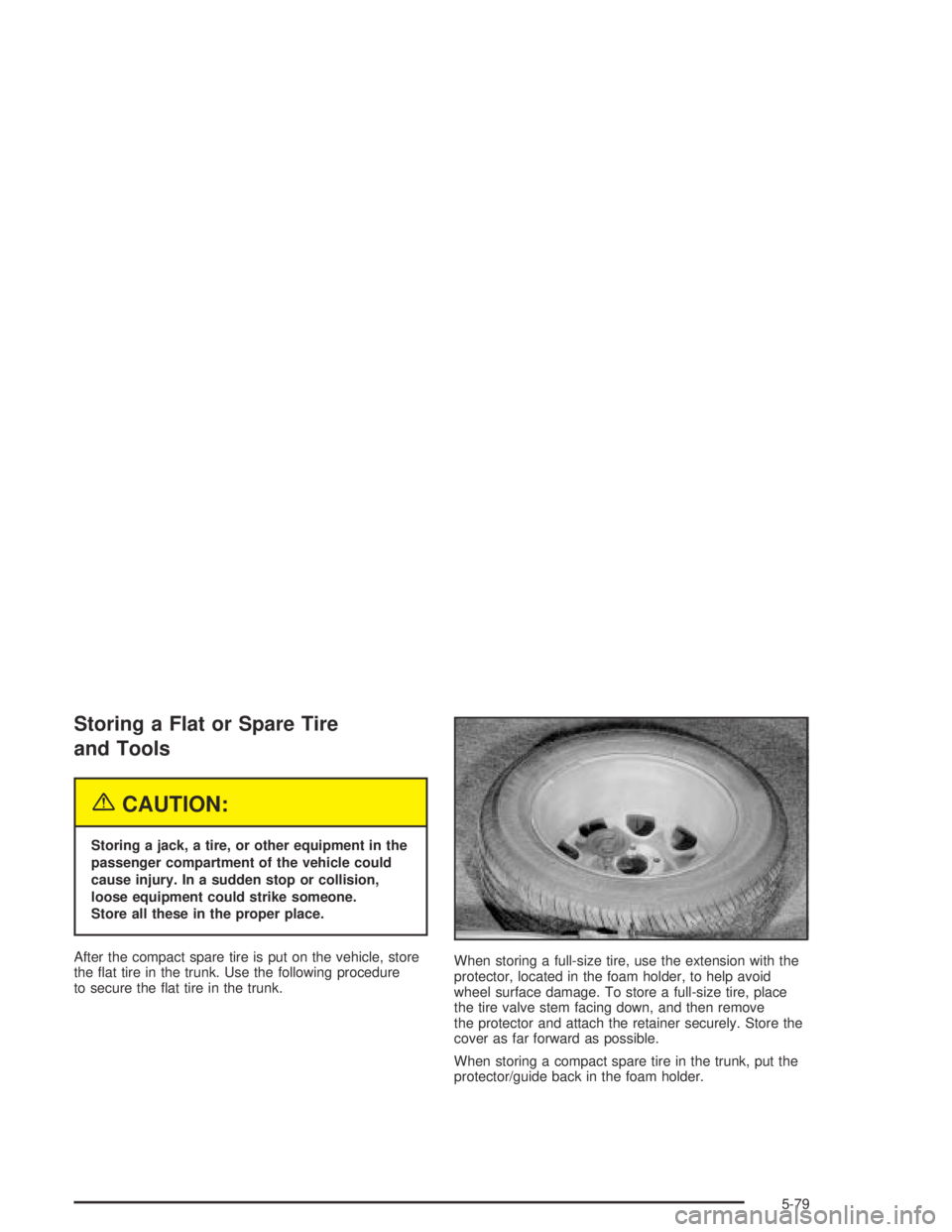
Storing a Flat or Spare Tire
and Tools
{CAUTION:
Storing a jack, a tire, or other equipment in the
passenger compartment of the vehicle could
cause injury. In a sudden stop or collision,
loose equipment could strike someone.
Store all these in the proper place.
After the compact spare tire is put on the vehicle, store
the �at tire in the trunk. Use the following procedure
to secure the �at tire in the trunk.When storing a full-size tire, use the extension with the
protector, located in the foam holder, to help avoid
wheel surface damage. To store a full-size tire, place
the tire valve stem facing down, and then remove
the protector and attach the retainer securely. Store the
cover as far forward as possible.
When storing a compact spare tire in the trunk, put the
protector/guide back in the foam holder.
5-79
Page 316 of 348

Engine Coolant Level Check
Check the engine coolant level and add DEX-COOL®
coolant mixture if necessary. SeeEngine Coolant
on page 5-22for further details.
Windshield Washer Fluid Level Check
Check the windshield washer �uid level in the windshield
washer tank and add the proper �uid if necessary.
At Least Once a Month
Tire In�ation Check
Visually inspect your tires and make sure tires are
in�ated to the correct pressures. Do not forget to check
your spare tire. SeeTires on page 5-53for further
details. Check to make sure the spare tire is stored
securely. Push, pull and then try to rotate or turn
the spare tire. If it moves, tighten it. SeeChanging a
Flat Tire on page 5-70.
At Least Once a Year
Starter Switch Check
{CAUTION:
When you are doing this inspection, the
vehicle could move suddenly. If the vehicle
moves, you or others could be injured.
1. Before you start, be sure you have enough room
around the vehicle.
2. Firmly apply both the parking brake and the regular
brake. SeeParking Brake on page 2-24if necessary.
Do not use the accelerator pedal, and be ready to
turn off the engine immediately if it starts.
3. Try to start the engine in each gear. The starter
should work only in PARK (P) or NEUTRAL (N).
If the starter works in any other position, contact
your GM Goodwrench dealer for service.
6-10
Page 331 of 348
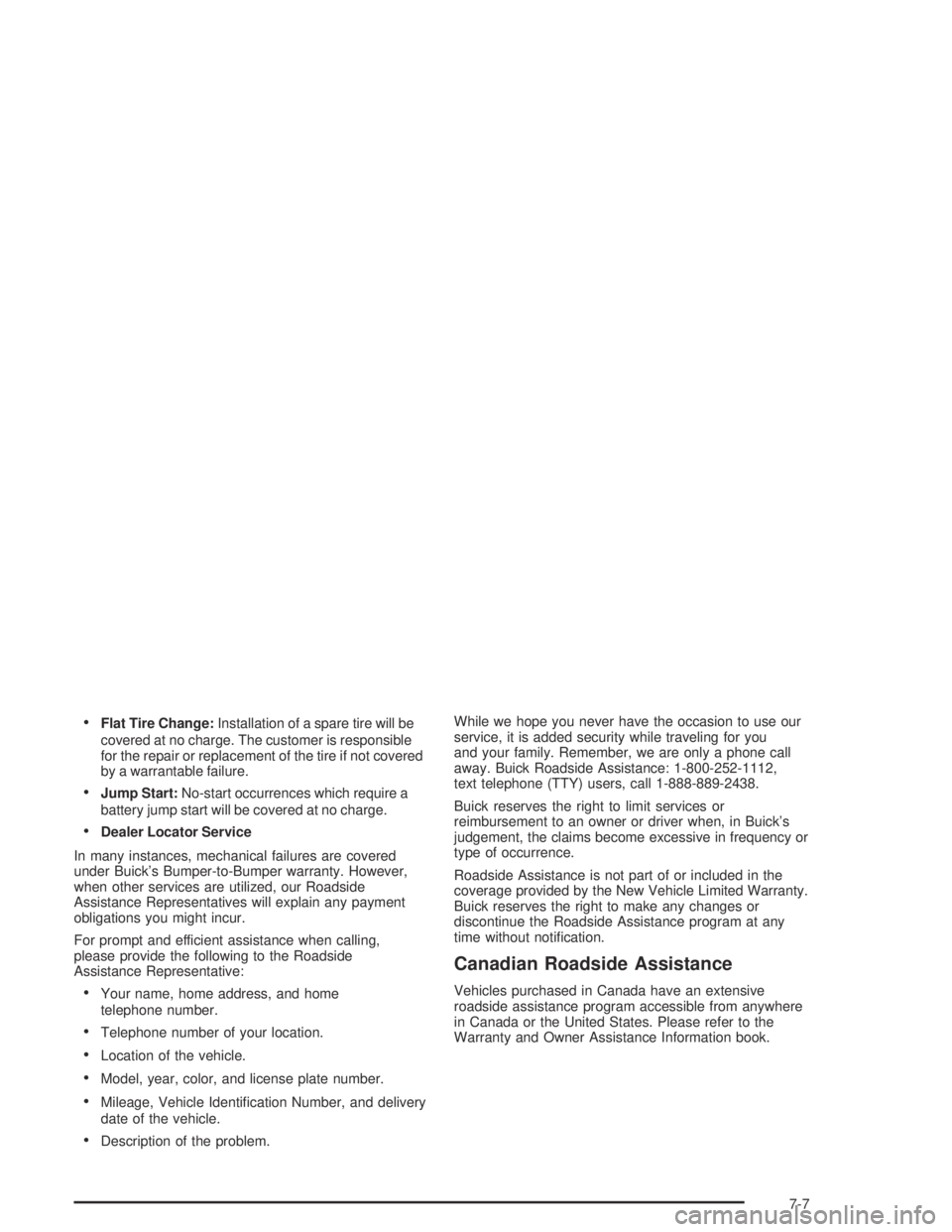
Flat Tire Change:Installation of a spare tire will be
covered at no charge. The customer is responsible
for the repair or replacement of the tire if not covered
by a warrantable failure.
Jump Start:No-start occurrences which require a
battery jump start will be covered at no charge.
Dealer Locator Service
In many instances, mechanical failures are covered
under Buick’s Bumper-to-Bumper warranty. However,
when other services are utilized, our Roadside
Assistance Representatives will explain any payment
obligations you might incur.
For prompt and efficient assistance when calling,
please provide the following to the Roadside
Assistance Representative:
Your name, home address, and home
telephone number.
Telephone number of your location.
Location of the vehicle.
Model, year, color, and license plate number.
Mileage, Vehicle Identi�cation Number, and delivery
date of the vehicle.
Description of the problem.While we hope you never have the occasion to use our
service, it is added security while traveling for you
and your family. Remember, we are only a phone call
away. Buick Roadside Assistance: 1-800-252-1112,
text telephone (TTY) users, call 1-888-889-2438.
Buick reserves the right to limit services or
reimbursement to an owner or driver when, in Buick’s
judgement, the claims become excessive in frequency or
type of occurrence.
Roadside Assistance is not part of or included in the
coverage provided by the New Vehicle Limited Warranty.
Buick reserves the right to make any changes or
discontinue the Roadside Assistance program at any
time without noti�cation.
Canadian Roadside Assistance
Vehicles purchased in Canada have an extensive
roadside assistance program accessible from anywhere
in Canada or the United States. Please refer to the
Warranty and Owner Assistance Information book.
7-7
Page 338 of 348

B
Battery..........................................................5-39
Run-Down Protection...................................3-17
Before Leaving on a Long Trip.........................4-22
Brake
Anti-Lock Brake System (ABS)........................ 4-7
Emergencies................................................ 4-9
Parking......................................................2-24
System Warning Light..................................3-32
Brakes..........................................................5-36
Braking........................................................... 4-6
Braking in Emergencies..................................... 4-9
Break-In, New Vehicle.....................................2-17
Bulb Replacement...........................................5-47
Back-Up Lamps...........................................5-51
Center High-Mounted Stoplamp (CHMSL)........5-49
Front Turn Signal and Parking Lamps.............5-48
Halogen Bulbs............................................5-47
Headlamp Aiming........................................5-45
Headlamps.................................................5-47
Replacement Bulbs......................................5-51
Taillamps, Turn Signal, and Stoplamps............5-50
Buying New Tires...........................................5-64
C
California Fuel.................................................. 5-6
Canadian Owners................................................ ii
Capacities and Speci�cations............................5-96Carbon Monoxide...................2-12, 2-27, 4-26, 4-38
Care of
Safety Belts................................................5-85
Your Cassette Tape Player............................3-65
Your CD Player...........................................3-66
Your CDs ...................................................3-66
Center High-Mounted Stoplamp (CHMSL)...........5-49
Center Passenger Position, Safety Belts.............1-20
Chains, Tire...................................................5-68
Charging System Light....................................3-32
Check
Engine Light...............................................3-36
Checking Things Under the Hood......................5-10
Chemical Paint Spotting...................................5-88
Child Restraints
Child Restraint Systems...............................1-33
Infants and Young Children...........................1-30
Lower Anchorages and Top Tethers for
Children (LATCH System)..........................1-40
Older Children.............................................1-27
Securing a Child Restraint Designed for
the LATCH System...................................1-42
Securing a Child Restraint in a Center
Rear Seat Position...................................1-44
Securing a Child Restraint in a Rear
Outside Seat Position...............................1-42
Securing a Child Restraint in the Right
Front Seat Position...................................1-46
Top Strap...................................................1-37
2
Page 343 of 348

LATCH System
Child Restraints...........................................1-40
Securing a Child Restraint Designed for
the LATCH System...................................1-42
Leaving Your Vehicle.......................................2-12
Light
Airbag Readiness........................................3-31
Anti-Lock Brake System Warning...................3-33
Brake System Warning.................................3-32
Change Engine Oil......................................3-40
Charging System.........................................3-32
Cruise Control.............................................3-41
Door/Trunk Ajar Warning...............................3-42
Engine Coolant Temperature Warning.............3-35
Enhanced Traction System (ETS)
Warning Light..........................................3-34
Low Fuel Warning.......................................3-43
Low Traction...............................................3-34
Low Washer Fluid Warning...........................3-41
Malfunction Indicator....................................3-36
Oil Pressure...............................................3-40
Safety Belt Reminder...................................3-30
Security.....................................................3-41
Service Vehicle Soon...................................3-42
Tire Pressure..............................................3-36
Lighting
Delayed Entry.............................................3-16
Delayed Exit...............................................3-17
Entry.........................................................3-16Lockout Protection..........................................2-12
Locks
Door..........................................................2-10
Leaving Your Vehicle....................................2-12
Lockout Protection.......................................2-12
Power Door................................................2-11
Programmable Automatic Door Locks.............2-11
Loss of Control...............................................4-15
Low Fuel Warning Light...................................3-43
Low Traction Light..........................................3-34
Low Washer Fluid Warning Light.......................3-41
M
Maintenance Schedule
Additional Required Services........................... 6-6
At Each Fuel Fill........................................... 6-9
At Least Once a Month................................6-10
At Least Once a Year..................................6-10
Introduction.................................................. 6-2
Maintenance Footnotes.................................. 6-8
Maintenance Record....................................6-16
Maintenance Requirements............................. 6-2
Normal Maintenance Replacement Parts.........6-14
Owner Checks and Services........................... 6-9
Recommended Fluids and Lubricants.............6-13
Scheduled Maintenance................................. 6-4
Using Your................................................... 6-2
Your Vehicle and the Environment................... 6-2
7